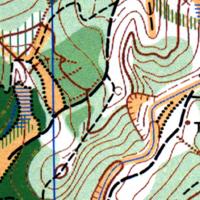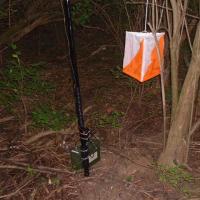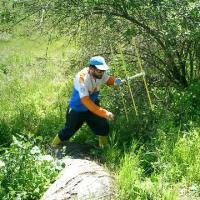What is ARDF?
 | |
Topographic maps show forest density, clearings, trails, elevation,
earthen banks, gullies, and other features of the terrain. Most ARDF
maps are 1:10,000 or 1:15,000 scale.
|
Amateur Radio Direction Finding (ARDF) is the sport of finding radio
transmitters on foot, using radio receiver, map, and compass in
diverse, wooded terrain. ARDF joins orienteering skills like the
proper use of topographic maps, compass skills, and locational awareness,
with radio direction finding skills using hand-held portable receivers
and antennas. It is great fun for young and old alike - an opportunity
for personal challenge in the great outdoors!
ARDF competitors use only topographic maps and compasses for navigation. Five
radio transmitters are hidden in the woods with standard orienteering control
flags and punches at each transmitter. Competitors carry portable radio
receivers with directional antennas with which they try to find the
transmitters. Competitors must punch a card they carry with them at each
transmitter to prove they have found it. A typical ARDF course will be four
to ten kilometers long. Competitors start in five minute intervals, so
everyone hears transmitter number one when they first turn on their
receivers. Winners are determined by those who find the most transmitters
in the fastest overall time.
 | |
A typical transmitter and antenna for the 80 meter band. An orange and white
control flag like this one is located at each transmitter location.
|
Each transmitter sends a simple Morse code identification for one minute
before going silent and the next transmitter, in sequence, sends its
identification for one minute. Each transmitter is therefore silent for
four minutes at a time. Even if you don't know the Morse code, it's easy
to figure out which of the five transmitters is sending out its signal -
just count the number of dits sent in a row:
one,
two,
three,
four, or
five.
Locating a hidden transmitter is done by taking bearings and signal strength
indications from multiple locations. With practice, you can learn to
use your radio receiving equipment well, and become an excellent judge of
radio propagation.
ARDF competitors are divided into classes based on age and gender. There
are currently 11 classes in international competition: W19 (women 19 years
old and younger,) W21 (any women,) W35 (women 35 years old or older,) W50
(women 50 years old or older,) W60 (women 60 years old or older,)
M19 (men 19 years old or younger,) M21 (any men,) M40 (men 40 years old or
older,) M50 (men 50 years old or older,) M60 (men 60 years old or older,)
and M70 (men 60 years old or older.) Anyone can enter W21 or M21 regardless
of age. The only class that must find all five transmitters is M21. The
W19, W21, W35, M19, M40, and M50 classes must find four transmitters, while
the W50, W60, M60, and M70 classes must find three transmitters. ARDF is
a life sport - one that encourages mental and physical activity for all
ages and abilities!
 | |
An ARDF competitor carrying a portable receiver and antenna for the
two meter band.
|
Because the competitors themselves never transmit, only receive, you do not
need an Amateur Radio license to enjoy ARDF! If you enjoy building electronic
equipment, there are many kits and circuit designs for ARDF receivers and
antennas. Many ARDF competitors use only home-built equipment. ARDF is also
a great sport for learning how to navigate in the woods with a map and compass.
Making good route decisions and always knowing where you are and where you
want to go are important skills that ARDF can help teach. ARDF can be an
excellent educational opportunity for young minds. Hunting hidden
transmitters in the forest is a great way to involve youth in a fun outdoor
activity that involves the science and technology of Amateur Radio. ARDF
has a lot to offer - it is a fun, challenging outdoor skill activity for
everyone!
|

